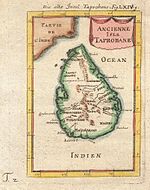Polonnaruwa period
| Polonnaruwa period | |||
|---|---|---|---|
| 1017–1232 | |||
 | |||
| Including |
| ||
| Monarch(s) | |||
Chronology
| |||
| History of Sri Lanka | ||||||||||||||
|---|---|---|---|---|---|---|---|---|---|---|---|---|---|---|
 | ||||||||||||||
| Chronicles | ||||||||||||||
|
||||||||||||||
| Periods | ||||||||||||||
|
||||||||||||||
| By Topic | ||||||||||||||
|
||||||||||||||
The Polonnaruwa period was a period in the history of Sri Lanka from 1017, after the Chola conquest of Anuradhapura and when the center of administration was moved to Polonnaruwa, to the end of the Kingdom of Polonnaruwa in 1232.
The
Kingdom of Ruhuna
, in which the Sinhalese Kings ruled during Chola occupation.
Overview
Periodization of Sri Lanka history:
| Dates | Period | Period | Span (years) | Subperiod | Span (years) | Main government |
|---|---|---|---|---|---|---|
| 300,000 BP–~1000 BC | Prehistoric Sri Lanka | Stone Age
|
– | 300,000 | Unknown | |
| Bronze Age | – | |||||
| ~1000 BC–543 BC | Iron Age
|
– | 457 | |||
| 543 BC–437 BC | Ancient Sri Lanka | Pre-Anuradhapura | – | 106 | Monarchy | |
| 437 BC–463 AD | Anuradhapura | 1454 | Early Anuradhapura
|
900 | ||
| 463–691 | Middle Anuradhapura
|
228 | ||||
| 691–1017 | Post-classical Sri Lanka | Late Anuradhapura
|
326 | |||
| 1017–1070 | Polonnaruwa | 215 | Chola conquest | 53 | ||
| 1055–1232 | 177 | |||||
| 1232–1341 | Transitional | 365 | Dambadeniya
|
109 | ||
| 1341–1412 | Gampola
|
71 | ||||
| 1412–1597 | Early Modern Sri Lanka | Kotte
|
185 | |||
| 1597–1815 | Kandyan | – | 218 | |||
| 1815–1948 | Modern Sri Lanka | British Ceylon | – | 133 | Colonial monarchy | |
| 1948–1972 | Contemporary Sri Lanka | Sri Lanka since 1948 | 76 | Dominion | 24 | Constitutional monarchy |
| 1972–present | Republic | 52 | Unitary semi-presidential constitutional republic |
Political history
Chola conquest (1017–1056)
The Chola conquest began with the invasion in 993 AD, when
Kingdom of Polonnaruwa (1056–1232)
Mahavamsa
to include Parakramabahu.
See also
- Mahavamsa
- Architecture of ancient Sri Lanka
- Sinhala Kingdom
- List of Sinhalese monarchs
References
- ^ Chattopadhyaya, pp 7–9
- ^ Indian History with Objective Questions and Historical Maps Twenty-Sixth Edition 2010, South India page 59
- ISBN 978-981-230-937-2.
- ISBN 978-1-932705-48-5.
- ^ Broheir, R. L. (1937) Ancient Irrigation Works in Ceylon. 3 vols.
